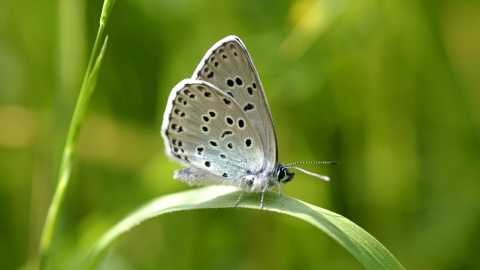
David J Slater
Daneway Banks
Its slopes are rich with wildflowers and home to a variety of butterflies, and is widely regarded as one of the best places in the world to see the large blue butterfly.
Location
Know before you go
Dogs
When to visit
Opening times
Open access throughout the yearBest time to visit
Spring to autumnAbout the reserve
The limestone grassland at Daneway Banks is a rare survivor. In spring and summer this sloping nature reserve comes alive with a wealth of wildflowers, including rock-rose, cowslip and orchids. The wildflowers attract a diverse range of insects, such as dingy skipper butterflies and six-spot burnet moths, which in turn bring a variety of birds
The quality of the habitats found here led to it being chosen for a project to reintroduce the large blue butterfly, which went extinct in the UK in the 1970s. Eggs collected on a Swedish island were brought to the reserve and in just a few years, Daneway Banks has become world renowned as a great place to see this butterfly with the world’s largest population recorded here in 2019. The best months to see large blues are June or July, depending on the weather.
One of the most striking features of the nature reserve is the large ant hills made by the yellow meadow ant. These small mounds are particularly noticeable in winter when they contribute to a lunar-like landscape. In some parts of Gloucestershire these are known as ‘emmet casts’ after the old English word for ant, and they’re often visited by woodpeckers, which dig holes with their bills to get to the ants inside.
Daneway Banks has been untouched by modern farming methods, which means it remains an excellent example of limestone grassland. GWT has leased it since 1968 and purchased it in 2016 after one of its biggest fundraising campaigns to date. Chief Executive Roger Mortlock has described it as ‘one of our most treasured and diverse limestone grassland sites’.
Other species to keep an eye out for are the rare cut-leaved germander and cut-leaved selfheal plant, both of which flower in late summer. Also, keep an eye out for dark green fritillary, marbled white, and small blue butterflies.
A vital part of the management of Daneway Banks involves the grazing of hardy native species of sheep and ponies at different times throughout the year.
Find out more about Gloucestershire's large blue butterflies
Species
Environmental designation
Looking after wildflowers
A critical part of the large blue butterfly is the laying of their eggs on wild thyme. While the eggs are developing they are particularly sensitive to disturbance.
We'd like everyone to be able to enjoy the wildflowers and to look for the large blues, but please do stick to the paths to avoid standing on any plants that harbour butterfly eggs.
By sticking to the paths, you are ensuring the large blue and many other insect and flower species will continue to flourish and be there for future generations.
More detailed directions
Standing on the bridge with the pub on your right, take the road on the left. Follow this road approximately 150m upwards, and you will find the entrance to the reserve on your right.
From Stroud
From A46 / A419 roundabout, follow the A419 east of Stroud for 6.8 miles. At the Chapmans Cross crossroads (look for a sign marked Sapperton/Cherington) turn north towards Sapperton. After 0.9 miles turn left at the crossroads signed towards Edgeworth/Bisley. After 0.7 miles you will see The Daneway Inn on the right hand side.
From Cirencester
Head west on the A429/Bristol Road. At the Stroud Road roundabout take the third exit/A419 west towards Stroud for 3.4 miles. Then take a slight right towards Sapperton and follow for 1.7 miles. The Daneway Inn will be on your right.
From Cheltenham or Gloucester
From the Air Balloon roundabout take the A417 to Stroud. After 0.9 miles turn right onto the B4070 and stay on this road through Birdlip and for another 2.1 miles. Turn left onto Calf Way at the Fostons Ash Inn, then left again after 0.2 miles. Continue for 3.3 miles. The Daneway Inn will be on your left.
Parking capacity
The best place to park is in the lay-by on the other side of the bridge from The Daneway Inn. Please park considerately.

